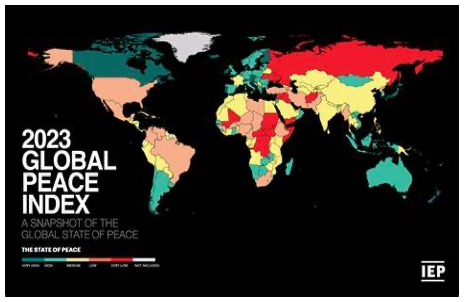
Global Peace Index Report: Nigeria Ranking Out Of 163 Countries Disturbing
The Global Peace Index (GPI) Produced by the Institute for Economics & Peace (IEP), is the world’s leading measure of global peacefulness. The 18th edition of the GPI, ranks 163 independent states and territories according to their level of peacefulness, covering 99.7 per cent of the world’s population.
The executive summary of the report presents the most comprehensive data-driven analysis to-date on trends in peace, its economic value, and how to develop peaceful societies. The GPI uses 23 qualitative and quantitative indicators from highly respected sources and measures the state of peace across three domains: the level of Societal Safety and Security; the extent of Ongoing Domestic and International Conflict; and the degree of Militarisation.
This year it introduces a new measure of global military capability that incorporates military sophistication, technology, and battle readiness into a single measure. The report finds that many of the conditions that precede major conflicts are higher than they have been since the end of the Second World War. There are currently 56 active conflicts, the most since the end of Second World War, and with fewer conflicts being resolved, either militarily or through peace agreements. The number of conflicts that ended in a decisive victory fell from 49 per cent in the 1970s to nine per cent in the 2010s, while conflicts that ended through peace agreements fell from 23 per cent to four per cent over the same period.
Conflicts are also becoming more internationalised, with 92 countries now engaged in a conflict beyond their borders, the most since the inception of the GPI in 2008, complicating negotiation processes for a lasting peace and prolonging conflicts. The internationalisation of conflict is driven by increased great power competition and the rise of middle level powers, who are becoming more active in their regions. Although the measures of militarisation had been improving for the first 16 years of the GPI, the trend has now reversed and in 2024 militarisation deteriorated in 108 countries. The combination of these factors means that the likelihood of another major conflict is higher than at any time since the inception of the GPI. This year’s results found that the average level of global peacefulness deteriorated by 0.56 per cent. This is the 12th deterioration in peacefulness in the last 16 years, with 65 countries improving and 97 deteriorating in peacefulness. This is the highest number of countries to deteriorate in peacefulness in a single year since the inception of the index.
Iceland remains the most peaceful country in the world, a position it has held since 2008. It is joined at the top of the index by Ireland, Austria, New Zealand, and Singapore. All of these countries other than Singapore were also ranked among the ten most peaceful countries in the first year of the index. Yemen is the least peaceful country in the world in the 2024 GPI, followed by Sudan, South Sudan, Afghanistan, and Ukraine. This is the first year that Yemen has been ranked as the least peaceful country in the world, with the country having fallen 24 places in the rankings since the inception of the index. The gap between the most and least peaceful countries in the world is now wider than it has been at any point in the last 16 years. Compared to 2008, the 25 most peaceful countries were one per cent more peaceful in 2024, while the 25 least peaceful countries were 7.5 per cent less peaceful. The conflict in Gaza has had a very strong impact on global peacefulness, with Israel and Palestine having the first and fourth largest deteriorations in peacefulness respectively. Ecuador, Gabon, and Haiti were the other countries with the largest deteriorations in peacefulness. El Salvador had the largest improvement on the index, due to very significant improvements in the homicide rate indicator and citizens’ improved perceptions of safety over the past few years. The United Arab Emirates, Nicaragua, and Greece also recorded significant improvements in peacefulness. Europe is the most peaceful region in the world and is home to eight of the ten most peaceful countries. It has been the most peaceful region every year since the start of the GPI.
The Middle East and North Africa (MENA) region remained the world’s least peaceful region. The report suggests that, Nigeria, Africa most populous country, has been ranked one of the least peaceful countries in the world, alongside Mali, Somalia, Burkina faso, Central African Republic with Nigeria ranking 147 out of 163 countries in the Global Peace Index report as of 2024. In 2023, Nigeria was equally ranked one of the least peaceful countries in the world, ranking 144 out of 163 countries in the Global Peace Index report as of December 2023.
North America recorded the largest average deterioration of all the regions, with significant falls in peacefulness in both Canada and the US. However, despite this deterioration it remains the third most peaceful region globally, behind Europe and Asia-Pacific. Of the 23 indicators in the GPI, eight recorded improvements, 13 deteriorated, and two recorded no change. The Militarisation and Ongoing Conflict domains both deteriorated, while the Safety and Security domain recorded a slight improvement. The largest year-on-year deteriorations occurred on the UN peacekeeping funding, military expenditure (% of GDP), deaths from external conflict, and external conflicts fought indicators. The deterioration on the military expenditure (% of GDP) reflects the deterioration on the Militarisation domain more broadly.
There were substantial improvements for many Safety and Security indicators, including violent demonstrations, terrorism impact and the homicide rate. Several countries in the Central America and Caribbean region recorded very large reductions in the number of homicides, though the region still had the highest average homicide rate of any region. The world has become less peaceful over the past 16 years, with the average country score deteriorating by 4.5 per cent since the inception of the index in 2008. Of the 163 countries in the GPI, 95 recorded deteriorations, while 66 recorded improvements and two recorded no change. Seventeen of the 23 GPI indicators deteriorated between 2008 and 2023 while seven improved. Two of the three GPI domains deteriorated since 2008, with Ongoing Conflict deteriorating by 19.1 per cent and Safety and Security deteriorating by 1.7 per cent. Militarisation was the only domain to improve, although this trend has begun to reverse over the past four years. Some of the largest indicator deteriorations were for external conflicts fought, internal conflicts fought, number of refugees and IDPs, and violent demonstrations. The 2024 GPI looks at how warfare and violent conflict is changing in the 21st century. There has been a significant rise in both conflicts and battle deaths in the past two decades, with battle deaths reaching a thirty-year high in 2022. Regional conflicts such as the RussiaUkraine war and the Gaza conflict illustrate the devastating human cost and the complexity of modern warfare. The Russia-Ukraine conflict has seen over 2,000 fatalities per month for almost every month in the past two years, while neither side is making significant gains. The Gaza conflict has resulted in over 35,000 deaths since October 2023, resulting in a severe humanitarian crisis. These conflicts are examples of ‘forever wars’, where prolonged violence becomes seemingly endless without clear resolutions, exacerbated by external military support, asymmetric warfare, and geopolitical rivalries. War in the 21st century is changing as a result of two key trends: changes in military technology and increasing geopolitical competition. Non-state groups can now engage more effectively with larger states using technologies like drones and improvised explosive devices. The use of drones has surged, with non-state groups increasing drone attacks by over 1,400 per cent since 2018. This shift has made conflicts more complex and harder to resolve. Geopolitical shifts further complicate global conflict management. The transition from a unipolar world dominated by the United States to a multipolar one has intensified competition and prolonged conflicts. Traditional powers like the US and the EU are stretched thin, limiting their ability to manage global tensions effectively.
Meanwhile, emerging powers such as China, Russia, and regional middle powers are increasingly vying for influence in conflict-affected areas around the world. The report also introduces a new machine learning methodology developed by IEP to assess military capability more accurately by accounting for technological differences in military assets. This method evaluates military strength by considering both the quantity and quality of platforms, as well as battle experience and combat readiness, across four weapon categories: fixed-wing aircraft, rotary-wing aircraft, naval assets, and armoured vehicles. Using this method, global military capability has increased by ten per cent since 2014, despite a decline in military personnel. Among the major military powers, China has seen the most significant increase in military capability, while France and Russia have experienced slight contractions. The economic impact of violence on the global economy in 2023 was $19.1 trillion in purchasing power parity (PPP) terms. This figure is equivalent to 13.5 per cent of the world’s economic activity (gross world product) or $2,380 per person. Military and internal security expenditure accounts for over 74 per cent of the total economic impact of violence, with the economic impact of military spending alone accounting for $8.4 trillion in the past year. Many countries have experienced enormous falls in GDP as a result of violent conflict during that time. Ukraine’s economy shrank by an estimated 30 per cent in 2022 as a consequence of the Russian invasion, while some estimates suggest that the Syrian civil war led to a drop of 85 per cent of GDP. The key to building peacefulness in times of conflict and uncertainty is Positive Peace. It can also be used to forecast future falls in peacefulness, with accuracy rates of up to 80 per cent. Positive Peace is defined as the attitudes, institutions and structures that create and sustain peaceful societies. IEP has developed the Halo approach for capturing problems systemically and informing effective policies for building Positive Peace.
(Culled from the Institute for Economics & Peace. Global Peace Index 2024: Measuring Peace in a Complex World, Sydney, June 2024. Available from: http://visionofhumanity.org/resources))



